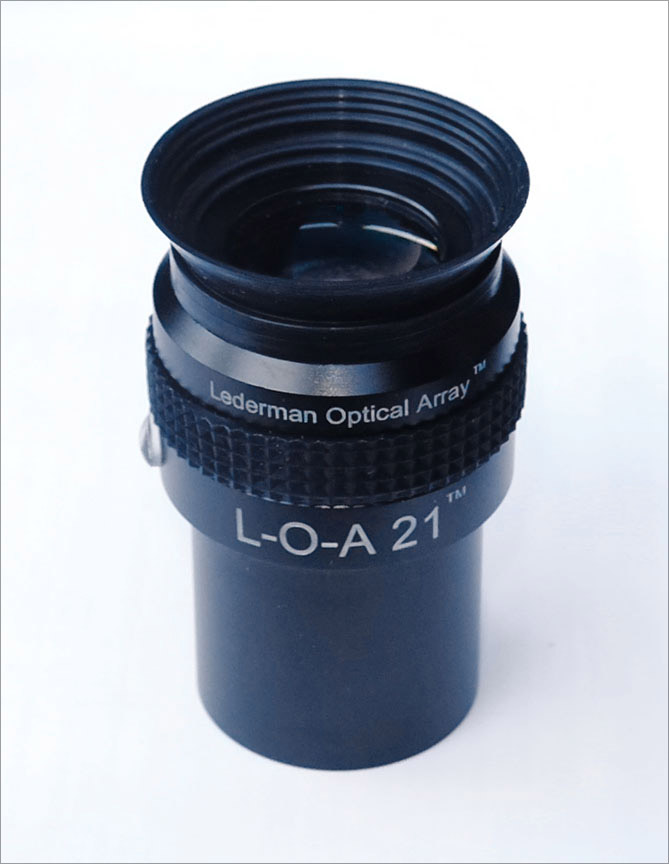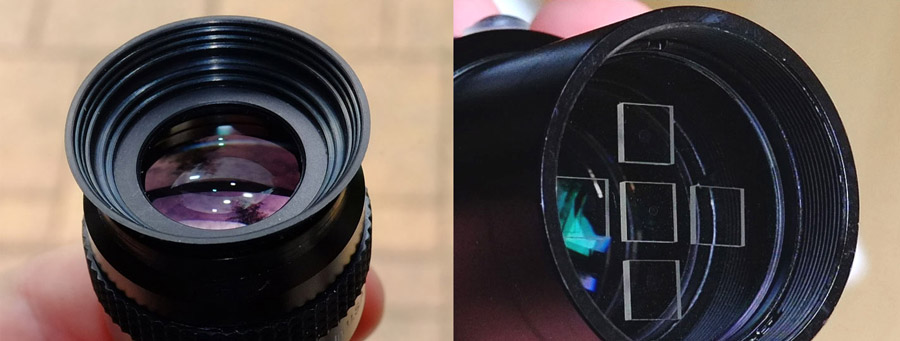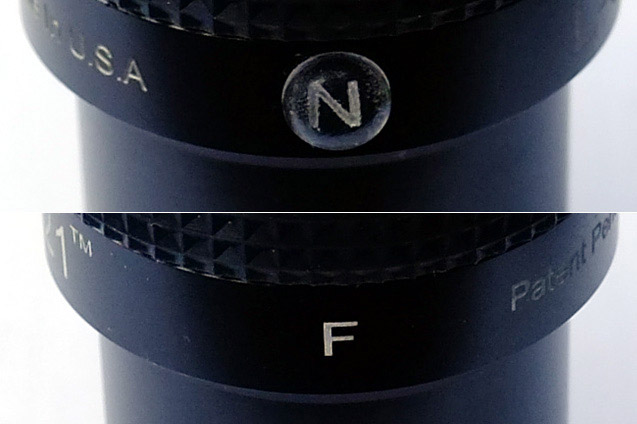The Lederman Optical Array LOA-21 3D Eyepiece
By: William A. PaoliniDiscuss this article in the forums
June 27, 20161. Equipment
The Lederman Optical Array LOA-21 eyepieces are a new ground breaking achievement in eyepiece technology that fundamentally changes amateur visual astronomy. The unique aspect of the new technology incorporated into these eyepieces is their ability to convey multiple distinctly visible layers of depth to the view! They transform the typical flat field rendering of a star field or deep space object viewed through a conventional eyepiece into one where the observer can see actual levels of depth, just as they can see with every day normal vision. Celestial views now burst into three dimensions. And depending on how you position the target or adjust the eyepiece’s rotation in the binoviewer, the target can be manipulated to the foreground, background, or any one of several levels in between. All the familiar celestial targets now take on a totally new character, one where they are alive and in three dimensions within their environment.

The LOA-21s are advertised with a 21mm focal length and a 65° apparent field of view. Eye relief is comfortable and in use eye positioning proved easy with no blackouts or kidney bean encountered. I measured their optical eye relief to be about 18mm -- approximately 14mm of this eye relief is usable when the eye guard is folded down. The LOA-21s are well built conveying a high quality impression. The housing and barrel appear to be an integrated unit of anodized aluminum and the barrel does not unscrew from the housing. A knurled rubber grip is around the housing for non-slip handling and the eye guard is a soft, easily foldable rubber material. The eye lens is nicely large, convex, and measures about 22mm across. The eyepiece has a good heft with most of the weight coming from the upper housing containing the optics.
For the 3D effect to be seen, the LOA-21 eyepieces must be used in a binoviewer. This is required because the brain requires inputs from two eyes to see parallax and then interpret that parallax into the familiar three dimensional view we see with ordinary vision (note - parallax is the effect where the position of an object appears to differ when viewed from different positions). The LOA-21s achieve their 3D rendering through a special "array" within the eyepiece. When you view the bottom of the array-enabled LOA-21 eyepiece, you will notice five small squares of a special optical glass. These five squares are the array element technology that alters portions of the field of view to create the parallax that the brain then interprets as depth enabling the view to show in actual three-dimensions.Only one eyepiece of the LOA-21s has the array elements within it to achieve this parallax. The second LOA-21 eyepiece used in the binovieweris a standard non-arrayed eyepiece. Russ Lederman of Denkmeier Optical is the inventor of this new technology, and it is offered now as a product on the Denkmeier Optical website along with their binoviewer and other products.

The LOA-21 eyepieces do not show the actual depth relationships of the objects in the field of view because to do this would require a binotelescope where the separation between the two objectives was sufficiently large, perhaps planetary distances apart, to show real parallax in the observation of distant celestial targets. The LOA-21s therefore show a simulated three-dimensional view. The LOA-21s also provide the observer with some added flexibility. By positioning a celestial object in particular array elements in the field of view, its depth in the foreground or background can be controlled. The observer can therefore tailor the view varying the depth by re-positioning the object they are viewing. Further, when the LOA-21 eyepiece with the array element is rotated 180 degrees, you can flip the depths provided by each array element. So as example, the center array element shows the object in the center of the field of view as being closest in the foreground, with all other objects in the field of view showing at several depth levels in the background. By rotating the eyepiece 180 degrees this flips the parallax effect and the central array element now shows the center object furthest away with the rest of the objects in the field of view now appearing at various levels in the foreground.
To make it easier for the observer to properly orient the rotation of the eyepiece, the LOA-21 with the array elements is marked on the housing with an "N" for near and an "F" for far.Conveniently, the "N" mark also has a clear rubber hemisphere dot over it allowing easy identification in the dark while observing.

When observing through the binoviewer the "N" and "F" marks should always be positioned up or down in relation to the binoviewer, and the mark positioned downward is how the central array element will portray the object centered in the field of view. So with the "N" pointing down in the binoviewer, the central portion of the field of view will then show the object as closest in the foreground. Rotating the eyepiece to a position that is left or right in orientation instead of up or down eliminates the parallax provided by the array elements thereby eliminating the 3D perspective from the field of view.
2. Observing
I have had multiple observing sessions with the LOA-21s, both from dark sites using a 20" f/5 Dobsonian and from my moderately light polluted suburban Virginia home west of Washington, D.C. using an 81mm f/7.7 Vixen Apo, a 102mm f/8 Takahashi TSA-102 Apo, and a 152mm Lunt f/7.9 Apo.
The LOA-21s have proven to be very easy to use, and I find them a little more comfortable than the Denkmeier 14mm eyepieces I typically use in my William Optics binoviewer. The apparent field of view of the LOA-21s is nicely sharp over the vast majority of the field of the view -- this is without the use of a Barlow or Optical Corrector on the binoviewer, which both my Lunt 152 and TSA-102 can do being bino-friendly telescopes. With a Barlow or Optical Corrector in place on the binoviewer, the field of view is nicely sharp to the edge.
My first observing experience with the LOA-21s was when they were still on prototype at the Delmarva Stargazers Club's Stargaze XXI event at the Trap Pond State Park in Delaware on May 16th, 2015. Then later I observed using the production eyepieces at a dark site in Berlin, Maryland. Both times observations were through Russ Lederman's 20" f/5 Dob. Finally, I have had multiple evenings of observing from my home using my 80mm, 102mm, and 152mm Apos.
At Trap Pond State Park in Delaware my observations were of a galaxy in the vicinity or Ursa Major (not M81-82), the Ring Nebula, and the globular cluster M3 using a 20” f/5 Dob. With M3 acquired, it was set in a somewhat rich field of view of surrounding stars in addition to the fairly large size for the glob itself. So on its own M3 was in a nicely rich and interesting field of view. Now when I normally observe globs my initial scrutiny is on context. I take in the glob in reference to its surroundings and I generally see it as being situated in the same plane as the other stars that may be in the field of view. Next, my focus turns to the core and I examine resolved stars in the center and try to imagine the object as a ball and imagine the resolved core stars being in front of the background glow of light that is the core. After that, my attention typically moves to the stars of the glob at the periphery of the cluster, examining how the density of stars becomes less and less until the outermost regions of the glob are reached. This is my typical observing process with a normal eyepiece. When I observed M3 with the LOA-21s, the experience was completely and entirely different! My first impression was "The glob is a sphere!" Then my second impression was "The glob is actually a sphere!!" This went on for quite a while as I was struck and mesmerized by the view. After a long time I finally turned my attention away from M3 and to the surrounding stars in the field of view, seeing them positioned at various depths from foreground to background. I then repositioned the scope numerous times and let the glob drift from end to end in the field of view through about every path available. As the glob drifted, sometimes it would slowly morph to a different perspective of depth and even stars within the glob would appear to move around in perspective of depth so that overall, it conveyed the impression that I was actually at the target in space and moving around it watching parallax perspectives change. So drift-viewing and tracking-viewing each provided a different quality of interesting and rewarding observation.
Observing a galaxy in Ursa Major, the 3D effect was also readily apparent with the galaxy positioned in the background and other stars in the field of view were in the foreground -- so the "F" mark on the eyepiece was pointing down in the binoviewer. This gave the view a correct perspective allowing me to actually see instead of just imagining that the object was outside our galaxy and beyond those foreground stars which are obviously stars within our galaxy. Seeing distant galaxies like this, correctly oriented in three-dimensional space was indeed a rewarding experience and added much to the interest level for this class of targets.
Turning to M57, which is an object I enjoy observing much more than galaxies, the effect was similarly rewarding. With a rotation of the LOA-21 arrayed eyepiece I was able to move the Ring Nebula between foreground and background orientations. After several experiments I found that I preferred this object in the background as being the most aesthetic perspective through the large 20” Dob. Interestingly, later at my home using my smaller aperture telescopes I preferred M57 being positioned in the foreground instead. So the flexibility to change depth orientation was a nice added feature of the LOA-21s as it definitely can make a difference in the view depending on how capable your telescope is and how dark the observing site is.
Moving to M17, the Swan Nebula, revealed a new observational 3D treat. In the 20" Dob both the nebula and a small cluster of stars just off the nebula filled almost the entire field of view. Through any other conventional eyepiece this would of course just have a perspective of all being in one plane. In the LOA-21s however, the Swan Nebula appeared to be canted at an angle with the leftmost portion appearing close, and the rightmost portion appearing further away, making it look like it was oriented at a 45° angle to me. The small cluster of stars just off to the lower right of the nebula were not just a flat grouping but instead were rendered in an engaging spherical arrangement like a little ball of stars. Simply spectacular! The multiple dimensions and orientations of this complex field of view were amazing to behold. I must say that I cannot wait until M42 comes around again to see that for the first time in 3D!
Moving locations to a less than dark site and now using smaller Apos, I was very curious if the 3D effect would be as dramatic and if deep space objects and star fields would look as interesting. What I discovered was that whether using my small 81mm Apo or my large 152mm Apo or a 20” Dob, the views were equally interesting mesmerizing to behold, particularly when the field of view was richly filled with stars. From my home with my smaller aperture refractors I chose a number of easy targets, mostly open clusters, brighter nebula, and then a few double stars. First up was M29, one of my favorite targets in Cygnus showing as a small square of stars with a few more stars coming off of two of the corners of the square making it look like a mini Great Square of Pegasus. For me this target is interesting enough as it is to observe being both delicate and bright. Through the LOA-21s the character of this target was now dramatically enhanced as the small square asterism stood clearly in the foreground closes to me, while the other stars in the field were at various levels in the background. Even in the little 81mm Apo this target was beautiful to behold and the depth perspective was dramatic and enhancing.
With typically magnitude 4 to 5 skies at my home during darker evenings, a little 81mm telescope will not show many nebula well unless they are very bright. But even so, I decided to try M27 the Dumbbell Nebula in my littlest 81mm Apo. There it sat in the field of view of the 81mm Apo as a dim circular fuzzy patch, and fairly large even at 48x. Still, as dim as it was, rotating the LOA-21s I could make the nebula move from far foreground to far background. In the end I preferred it best in the foreground as it better gave the impression of a nebula hanging in space in front of background stars. With a conventional eyepiece this target would be rather boring in a small aperture telescope. With the LOA-21s however it became fun, being able to move its position in space relative to the surrounding stars, then more interesting when positioned in such a way as to make it appear as if floating there in front of me.
Next I moved to NGC 6871, a nicely rich cluster of blue and white stars in Cygnus that contains about 50 members. Using the 81mm Apo the cluster filled a significant portion of the field of view at 48x with some of the brightest stars at the periphery of the cluster. As I observed the stars at varying depths I rotated the LOA-21 arrayed eyepiece from the near to the far setting to see how the perspective changed. For this cluster my preferences was the "F" setting so the center of the cluster was in the furthest background. Set like this the brighter periphery stars circled the background like a picture frame giving the entire cluster the impression of an actual funnel of stars in space, with the interior moving further into the distance as you observed down the center. An impressive display with a small 81mm telescope, and something no conventional eyepiece would ever be able to achieve.
Finally, I took my larger 102mm and 152mm Apos and used them for some showcase double star observing, as well as to revisit some of the open clusters, all of which showed equally well in their 3D splendor. For the doubles, I observed the two classics, Albiero in Cygnus and the Double-Double in Lyra. With Albiero, which is always a beauty to observe with its wonderfully rich and contrasting colors, the character of this double was even further enhanced using the LOA-21s. Placing it dead center in the field of view of the LOA-21s, Albiero showed itself in the very near foreground with all other stars in the field showing at various levels in the background. This perspective accentuated this showcase double even more giving the observer the impression they were approaching the double on a journey through space. On occasion, as Albiero drifted through the field of view, I had noticed earlier that the array elements of the LOA-21 would produce a double image artifact of brighter stars, so was not surprised it also happened with this relatively bright double star. This artifact seems to happen when brighter stars transition the edge of an array element so it is generally momentary unless the drifting is following an edge of an array element. When this did happen, all I did was to nudge the scope a little to reposition the offending star and the image double vanished. As observing continued over many evenings I came to mostly ignore this artifact as my perceptions were much more taken with the three-dimensional aspect of the views. For some this artifact may be bothersome, but overall I found it only a minor annoyance given everything else this new technology was providing.
Moving to the much more widely separated Double-Double in Lyra, the view was even more interesting as I placed one of the doubles in the center array element so it appeared closest in the foreground, and the other double being out of the central array element gave the Double-Double a perspective of being canted relative to my position in space. In my doubles observing over the years I have generally been restricting myself to only the closest doubles as I find widely separated doubles not that interesting to observe. With the LOA-21s however, wider doubles are now something intriguing to observe with their spatial orientation being customizable.
For what it is worth, I did try using the LOA-21s for non-deep space objects, which is now how they were designed to be used. So being curious I observed both Saturn and the Sun using a white light solar setup. In both cases I did not find them of any advantage. In one instance, I was able to place Saturn in such a way as one of its moons was outside an array element so it appeared nearer in space than the planet. But I felt this minimal depth improvement did not really enrich the observation. With white light solar observing since most of the solar surface has a uniform appearance, the parallax was not obvious to my eyes and I was unable to see any dimensionality. Based on this there seem to be a few targets, like solar and planetary, that the LOA-21s do not appear well suited. I would imagine that lunar might be the same as well. However, for all of the various catalogs of Messier, NGC, IC and other deep space objects, the LOA technology is in my estimation nothing less than profoundly game changing!
3. Conclusions
The LOA-21s and the new technology they introduce to astronomical observing has provided that long awaited next leap I have been eagerly looking for in visual astronomy. Instead of the normal litany of either larger apertures or larger apparent fields of view, for the first time in decades we now have a fundamental and dramatic improvement for visual observing. And while not suited for all celestial observing tasks, the LOA-21s are a transforming experience for the vast majority of celestial targets such as galaxies, nebula, doubles, open clusters, globular clusters, and even rich field scanning. Not being much of a wide field aficionado before the LOA-21s, with them I now find myself going off target all the time to be immersed in the 3D nature of just about any star field in the universe.The observing experience the LOA provides is so different from what I am used to with traditional eyepieces, even ones with apparent fields of view over 100 degree, that I now feel like I am seeing for the first time the many objects I have visited these past 45 years as an amateur astronomer. The views provided by the LOA-21s are natural, intuitive, and filled with the perspectives I see in everyday life; they make astronomical observing new and exciting again!
 About the Author
About the Author
William "Bill" Paolini has been actively involved in optics and amateur astronomy for 45 years, is author of the desk reference on astronomical eyepieces: Choosing and Using Astronomical Eyepieces which is part of the Patrick Moore Practical Astronomy Series published by Springer of New York, has published numerous product reviews on major online amateur astronomy boards, and volunteers with public tours at a famous vintage Clark refractor site.
Bill's professional background is as an officer in the U.S. Air Force and as a computer scientist, holding a Bachelor’s degree in Computer Science and a Master of Science in Education. He has worked for the U.S. Department of Defense, the U.S. Department of Commerce, the Federal Trade Commission, the Federal Reserve, the World Bank, and a variety of commercial corporations in the information technology, information technology security, and telecommunications industries.
Bill has been observing as an amateur astronomer since the mid-1960's, grinding mirrors for homemade Newtonian telescopes during the 1970's and eventually owning, using, and testing several hundreds of eyepieces in a wide variety of telescopes from Achromatic and Apochromat refractors to Newtonian, Maksutov-Cassegrain, and Schmidt-Cassegrain designs. Today he enjoys observing and testing new equipment from his suburban home west of Washington, D.C., where his primary amateur astronomy pursuits are lunar, planetary, bright nebula, open cluster, and globular cluster observing.
***
This article is placed in the public domain with no restrictions when made available in its entirety.
All images Copyright 2015 by William Paolini and require written permission if used apart from this article.
For a formatted PDF version of this article, please contact the author at wapaolini@hotmail.com
Dismiss Notice
New Cookie Policy
On May 24, 2018, we published revised versions of our Terms and Rules and Cookie Policy. Your use of AstronomyConnect.com’s services is subject to these revised terms.

